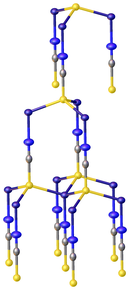Copper(I) thiocyanate
 Copper(I) thiocyanate
| |

| |
| Names | |
|---|---|
| Other names
Cuprous thiocyanate
| |
| Identifiers | |
| ChemSpider | |
ECHA InfoCard
|
100.012.894 |
PubChem CID
|
|
| UNII | |
CompTox Dashboard (EPA)
|
|
| Properties | |
| CuSCN | |
| Molar mass | 121.628 g/mol[1] |
| Appearance | white powder |
| Density | 2.88 g/cm3[2] |
| Melting point | 1,084[1] °C (1,983 °F; 1,357 K) |
| 8.427·10−7 g/L (20 °C) | |
Solubility product (Ksp)
|
1.77×10−13[3] |
| -48.0·10−6 cm3/mol | |
| Related compounds | |
Other anions
|
Copper(I) iodide, copper(I) cyanide |
Other cations
|
Ammonium thiocyanate Potassium thiocyanate |
Except where otherwise noted, data are given for materials in their standard state (at 25 °C [77 °F], 100 kPa).
| |
Copper(I) thiocyanate (or cuprous thiocyanate) is a coordination polymer with formula CuSCN. It is an air-stable, white solid used as a precursor for the preparation of other thiocyanate salts.
Structure
At least two
Synthesis
Copper(I) thiocyanate forms from the spontaneous decomposition of black copper(II) thiocyanate, releasing
Double salts
Copper(I) thiocyanate forms one double salt with the group 1 elements, CsCu(SCN)2. The double salt only forms from concentrated solutions of CsSCN, into which CuSCN dissolves. From less concentrated solutions, solid CuSCN separates reflecting its low solubility.[9] When brought together with potassium, sodium or barium thiocyanate, and brought to crystallisation by concentrating the solution, mixed salts will crystallise out. These are not considered true double salts. As with CsCu (SNC)2, copper(I) thiocyanate separates out when these mixed salts are redissolved or their solutions diluted.[10]
Uses
Copper(I) thiocyanate is a
CuSCN with NiO act synergically as a smoke suppressant additive in polyvinyl chloride (PVC).
CuSCN precipitated on carbon support can be used for conversion of aryl halides to aryl thiocyanates.[13]
Copper thiocyanate is used in some
References
- ^ a b "Properties of Copper(I) thiocyanate". Chemspider. Alfa Aesar 40220. Retrieved 5 January 2016.
- ^
- ISBN 978-1138561632.
- .
- ISSN 0020-1650.
- ^ Reece H. Vallance, Douglas F. Twiss and Miss Annie R. Russell (1931). J. Newton Friend (ed.). A text-book of inorganic chemistry, volume VII, part II. Charles Griffin & Company Ltd. p. 282.
- ^ H.L.Wells (1902). "On some double and triple thiocyanates". American Chemical Journal. 28: 245–284 (263).
- ^ Herbert E. Williams (1915). The chemistry of cyanogen compounds. J. & A. Churchill, London. pp. 202–203.
- ISBN 9780080914237. Retrieved 14 January 2017.
- ISBN 9781849731652. Retrieved 14 January 2017.
- ISBN 9780471187790. Retrieved 14 January 2017.
- ^ "Copper in Antifouling". Archived from the original on 2017-04-27. Retrieved 2017-04-25.
- ^ V.F. Vetere et al, "Solubility and Toxic Effect of the Cuprous Thiocyanate Antifouling Pigment on Barnacle Larvae", Journal of Coatings Technology, 69:39 (March 1997)
